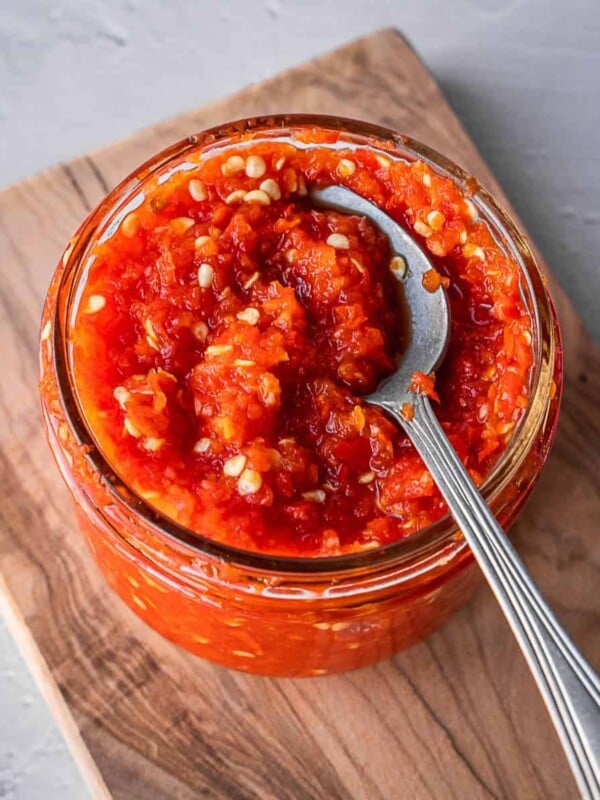Fermented Celery is delicious, tangy and a great way to transform fresh celery into something much more flavorful. Whether you are a beginner or an expert fermenter, this recipe breaks down everything you need to know from equipment to fermenting safety. All you need are a few simple and fresh ingredients and a little time.
This recipe is featured in my 11 Easy and Straightforward Fermentation Recipes post.

Table of Contents
What is Lacto-Fermentation?
lacto-fermentation (lactic acid fermentation) is a preservation method that involves submerging vegetables and fruits in a brine solution of salt and water. Rather than killing bacteria (vinegar pickling), fermenting takes a different approach.
When done correctly, fermentation kills or suppresses the bad bacteria while allowing the beneficial bacteria to thrive. This fermenting process transforms the vegetables and/or fruits into healthy lacto-fermented food with beneficial probiotics.
If you’ve ever tasted kimchee, Fermented jalapenos, fermented cherry tomatoes, fermented cabbage (sauerkraut), Fermented Sambal Oelek (Indonesian chili paste) or red cabbage sauerkraut, you’ll notice they have an acidity to them that is slightly different from a traditional vinegar based pickle.
Fermented foods are tangy as opposed to sour/pickled. They may even tingle on your tongue from the carbon dioxide that is created in the process of fermentation.
I encourage you to read my comprehensive post on lacto-fermentation, especially if you are a beginner or this is your first time fermenting. It’ll give you all the basics you need to confidently ferment all the fruits and vegetables! Also, make sure to try my fermented hot sauce recipe and fermented lemons.
Ingredients
This recipe comes together with a few ingredients. Use the freshest celery you can get your hands on. This recipe is perfect to make during the summer months when celery is at its peak.

- Celery: The stat of the show. Choose fresh, firm and blemish-free celery for this recipe. You ferment both the stalks and the inner leaves in this recipe. Grow your own celery or buy organic from one of your local grocery stores.
- Herbs and Spices: I recommend using woody herbs. Bay leaf is great because it adds a hint of flavor but the tannins in the leaf help keep the ferment crunchy. You can add other herbs and spices here like black pepper, pepper flakes, fresh dill, and coriander. You can even add celery seeds if you have them.
- Salt: When fermenting, use kosher salt, pickling salt, or sea salt. Avoid using table salt as it has added iodine which may affect vegetable fermentation.
- Garlic: I love using garlic in all my ferments but the choice is up to you. You can omit the garlic if you prefer.
See the recipe card for full information on ingredients and quantities.
Salt and Water Ratio
For this fermented celery recipe, you will be using a salt water brine solution to ferment the celery stalks. This technique can be applied to fermented radishes, fermented carrots, fermented tomatoes, fermented beets, giardiniera mix, and of course fermented cucumbers.
Filtered water or spring water is preferred over tap water because the chlorine in tap water could affect fermentation. I recommend using a 3.5% salt solution. This translates to 3.5 grams of salt per 100 grams of water. A good place to start is 1 tablespoon of sea salt or kosher salt to 2 cups of water (which works out to 17g of salt to 475g of water – a 3.5% ratio).
Equipment and Supplies
Fermentation lids (also known as airlocks or airlock lids) are not essential, but recommended. This is a lid with a special valve that allows gasses to escape safely avoiding any dangerous buildups of gas. The lids fit directly onto a standard mason jar. There are several options like the Klemon and Masontops (affiliate links).

You can use a standard mason jar lid and unscrew it twice a day to let any built-up air escape and quickly reseal. This option is not ideal as it can allow oxygen back in. I recommend using glass fermentation weight (affiliate link) which will keep the peppers submerged in the salt brine. These are also called pickle pebbles.
Use a wide-mouth mason jar because many of the fermenting lids mentioned above are designed specifically for it. This recipe calls for a ¾ quart (approx. 750ml) jar. Glass jars are ideal. I stay clear of metal and plastic containers (though there are many who use plastic containers for fermenting, I choose not to).
Fermenting fruits and vegetables is generally very safe. But to make sure that you are not introducing any bad bacteria or mold in the project and to have a successful ferment, keep your equipment and tools as clean as possible.
You don’t need to sterilize them (as you would if you are water bath canning), but washing everything in soapy warm water and air drying them is the best way to reduce the risk of cross-contamination.
How to Make Lacto Fermented Celery
This is a pretty straightforward recipe. Read through all the steps before you start.

Step 1. Prepare the saltwater brine. In a large measuring cup or jug, combine the water with salt. Mix well to dissolve the salt.

Step 2. Pack the jars. To your mason jar, add the garlic cloves, chopped celery and bay leaf.

Step 3. Add the fermenting weight. Add your fermentation weight to the jar, making sure that it does not go above the rim.

Step 4. Pour the brine. Carefully pour the brine solution into the jar, making sure all the celery is submerged.

Step 5. Apply the fermentation lid. Add the fermentation lid to the jar.

Step 6. Ferment. Ferment the celery for at least 5 days away from direct sunlight. On day 5, give it a taste. If you want the celery to be tangier and sourer, replace the weight and lid and continue to ferment for a few more days. If you’re happy with the taste, remove the weight, and fermentation lid. Apply a regular lid and refrigerate.
Fermentation Time, Safety and Storage
While the celery is fermenting keep it on the counter away from direct sunlight. The ideal temperature is room temperature, which is approximately 60°F to 75°F (15°C to 24°C).
Fermentation time will depend entirely on your preference. I recommend a minimum of 5 days. By the 5th day, you’ll notice that the brine may have become a little cloudy. That’s expected.
This is your indication that the lacto fermented celery is ready. Give it a taste. If you like it the way it is, you can proceed to the next step. If you prefer a more tangy flavor, you can do another couple of days of fermentation (or even up to 2 full weeks total).
Remember that the finished ferment must be refrigerated!

Expert Tips
- Change it up. Feel free to add some other vegetables to your mix like sliced onions and even peppers. You can also add some other herbs or spices like coriander.
- Clean equipment and clean jars! Wash your jars and utensils well before using them to prevent unwanted bacterial growth using hot soapy water. This is an option but you can sterilize them by boiling them in hot water for 5 minutes. The sterilization isn’t necessary, but does add an extra layer of protection.
- Safety first. Make sure to refrigerate your lacto fermented celery stalks when they are ready.
- Scale up or scale down. You can make this recipe in small batches throughout the summer season. What’s important is to maintain the salt water brine ratio.
- Use in salads. In addition to enjoying the fermented celery on its own, you can add it to chicken salad, potato salad and even egg salad.
Recipe FAQs
A cloudy brine is common with fermentation projects. It’s not really a cause for concern. A cloudy brine will typically form after a few days and is a result of microbial or yeast activity. It can also be from starches and proteins breaking down. Trust your senses. If something smells or looks off to you, it’s best to start over. Read the fermentation safety section in this post.
Kahm yeast is a type of surface yeast commonly found in fermenting foods such as kombucha, pickles, and sauerkraut. It forms as a thin, white film on the surface of the fermenting liquid and is generally harmless but can alter the flavor and texture of the food.
Other Fermentation Recipes
Fermentation
Fermentation
Fermentation
Fermentation
If you make this Fermented Celery recipe or any other fermentation recipe on Urban Farm and Kitchen, please take a moment to rate the recipe and leave a comment below. It’s such a help to others who want to try the recipe.
For more Urban Farm and Kitchen, follow along on Instagram, Facebook, and Pinterest, visit the Urban Farm Shop, or subscribe for new posts via email.
How to Make Fermented Celery (Easy and Delicious)

Equipment
- ¾ quart mason jar (24 fl oz mason jar)
- Regular canning jar lid
Ingredients
- 2 cups Fresh unchlorinated water
- 1 tbsp Kosher salt, sea salt or pickling salt
- ½ Head of celery – Cleaned, trimmed and cut into wedges or pieces
- 1-2 Garlic cloves
- 1-2 Bay leaves
Instructions
- Prepare the saltwater brine. In a large measuring cup or jug, combine the water with salt. Mix well to dissolve the salt.
- Pack the jars. To your mason jar, add the garlic cloves, chopped celery and bay leaf. Pack tightly to reduce the air pockets.
- Add the fermenting weight. Add your fermentation weight to the jar, making sure that it does not go above the rim.
- Pour the brine. Carefully pour the brine solution into the jar, making sure all the celery is submerged. Tap the jar to release any air bubbles.
- Apply the fermentation lid. Add the fermentation lid to the jar.
- Ferment. Ferment the celery for at least 5 days away from direct sunlight on the counter. On day 5, give it a taste. If you want the celery to be tangier and sourer, replace the weight and lid and continue to ferment for a few more days (you acn go up to 2 weeks total). If you’re happy with the taste, remove the weight, and fermentation lid. Apply a regular lid and refrigerate.
Notes
- Celery: The stat of the show. Choose fresh, firm and blemish-free celery for this recipe. You ferment both the stalks and the inner leaves in this recipe.
- Herbs and Spices: I recommend using woody herbs. Bay leaf is great because it adds a hint of flavor but the tannins in the leaf help keep the ferment crunchy.
- Salt: When fermenting, use pickling salt, Kosher salt, or sea salt. Avoid using table salt as it has added iodine which may affect fermentation.
- Garlic: I love using garlic in all my ferments but the choice is up to you. Use more or less, or none at all.
Nutrition
Nutrition information is automatically calculated, so should only be used as an approximation.
 Like this recipe? Rate & comment below!
Like this recipe? Rate & comment below!














